One of most complex learning designs we ever put together was the Crevasse Rescue scenario for the HSVO Project, funded by CANARIE.
The scenario showed how we were able to blend a complicated set of tools, resources and platforms across 5 centres, 5 time zones, 5 simulation platforms and 4 sets of learners. We used some very sophisticated, network enabled platforms, along with a bespoke integration suite called SAVOIR.
The story starts in the far north, where a glacial researcher (yes, he was too slow!) fell into a crevasse and had to be carefully extricated.
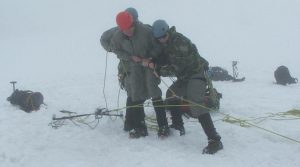
He is then transferred to the remote research base, his injuries are assessed, and then he has to be flown out to a tertiary care trauma centre.
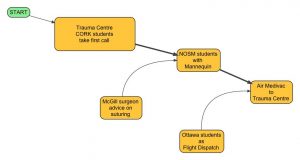
The various teams involved, across the five centres (NOSM, McGill, Ottawa, NRC and Cork) had to work together, and find a tricky balance between care and speed. To cap it all, a major storm was moving in so they could not take too long at each stage and must balance the risks for all concerned.
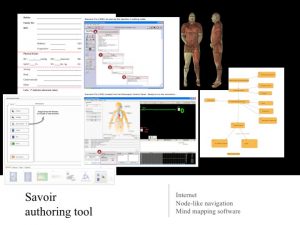
Coordination of the various educational resources was facilitated by the SAVOIR authoring tool. This allowed us to blend data flows and educational resources such as:
- Laerdal SimMan 3G
- OpenLabyrinth
- VolSeg virtual anatomy segmentation (Lacrosse, Wisconsin)
- McGill Virtual Camera Array
- HSVO user-directed light pipes
This project made excellent use of the high-speed networks and HPC clusters afforded by CANARIE.
In this video, we describe one of the earlier scenarios that we created for the ORION Summit:
This SketchUp model illustrates the room layout we used in our NOSM East sim lab:
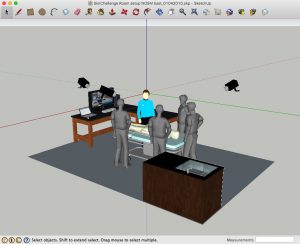
Although the Laerdal SimMan 3G allows some quite sophisticated programming of its mannequin scenarios, using Trends and Triggers…
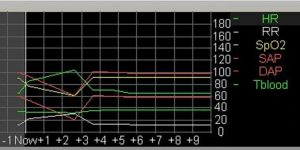
…we still found that the learning designs afforded by OpenLabyrinth were highly necessary as ‘conceptual glue’ to hold the scenarios together.
In this 5 minute video, John Spence describes the HSVO project in overview:
In this next video, Rachel Ellaway explains the idea behind the HSVO project:
In our later work, we included Second Life as a platform. This was less effective educationally as it was difficult to integrate the data flows and learning designs smoothly. Nonetheless, we finish with this final corny video, an animation of the rescue helicopter flying off into the sunset:
References:
-
Ellaway, R., Joy, A., Topps, D., & Lachapelle, K. (2013). Hybrid Simulation with virtual patients. Simulation in Healthcare : Journal of the Society for Simulation in Healthcare, 7(6), 392–468. Retrieved from http://www.dtic.mil/docs/citations/ADA560817
-
Ellaway, R. H., Topps, D., Lachapelle, K., & Cooperstock, J. (2009). Integrating simulation devices and systems. Stud Health Technol Inform, 142, 88–90. Retrieved from http://www.ncbi.nlm.nih.gov/pubmed/19377120
-
Ellaway, R., Topps, D., MacDonald, J., Copeland, B., Olmos, A., & Spencer, B. (2010). HSVO: A functional XML specification for integrating simulation devices. Bio-Algorithms and Med-Systems, 6(11), 47–51.
